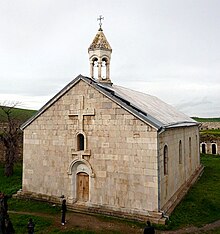This is an old revision of this page, as edited by Cirt (talk | contribs) at 19:42, 20 March 2010 (Protected Amaras Monastery: Edit warring / Content dispute ( (expires 19:42, 27 March 2010 (UTC)) (expires 19:42, 27 March 2010 (UTC)))). The present address (URL) is a permanent link to this revision, which may differ significantly from the current revision.
Revision as of 19:42, 20 March 2010 by Cirt (talk | contribs) (Protected Amaras Monastery: Edit warring / Content dispute ( (expires 19:42, 27 March 2010 (UTC)) (expires 19:42, 27 March 2010 (UTC))))(diff) ← Previous revision | Latest revision (diff) | Newer revision → (diff)| This article's factual accuracy is disputed. Relevant discussion may be found on the talk page. Please help to ensure that disputed statements are reliably sourced. (Learn how and when to remove this message) |
| Amaras Monastery Müqəddəs Qriqoris Məbədi Ամարաս վանք | |
|---|---|
 The church of St. Grigoris of the Amaras Monastery (established in the 4th century, rebuilt in the 19th century) The church of St. Grigoris of the Amaras Monastery (established in the 4th century, rebuilt in the 19th century) | |
| Religion | |
| Affiliation | Armenian Apostolic Church |
| Location | |
| Location | near Sos, Kojavend rayon, Nagorno-Karabakh, |
| Architecture | |
| Style | Armenian |
| Groundbreaking | 4th-19th century |
Amaras Monastery (Template:Lang-hy) is one of the oldest Christian sites in Nagorno-Karabakh, and is an Armenian Apostolic monastery located near the village of Sos in the Kojavend rayon of Azerbaijan Republic.
History
According to the 5th-century chronicler Faustus Byuzand, at the start of the 4th century St. Gregory the Illuminator founded a church in what was to become Amaras Monastery.
Amaras was the burial place of St. Gregory the Illuminator's grandson, St. Grigoris (died in 338). A tomb built for his remains still survives under the apse of the 19th-century church of St. Grigoris.

At the beginning of the 5th century Mesrop Mashtots, the inventor of the Armenian Alphabet, established in Amaras the first-ever school that used his script.
The monastery was plundered in the 13th century by the Mongols, destroyed in 1387 during Tamerlane's invasion, and demolished again in the 16th century. It underwent radical restructuring in the second quarter of the 17th century when the surviving defensive walls were constructed.
Amaras was later abandoned, and in the first half of the 19th century the monastery served as a frontier fortress for Russian imperial troops.
The Armenian Apostolic Church reclaimed the monastery in 1848. The monastery's church appears to have been severely damaged during the period of military occupation, to the extent that a new church had to be constructed on the site of the old one. This new church, dedicated to St. Grigoris, was built in 1858 and paid for by the Armenians of the city of Shusha. It still survives and is a three-nave basilica constructed from bright white stone.
The monastery was abandoned during the Soviet period.
Tomb of St. Grigoris
St. Grigoris was originally buried at the eastern end of the now vanished St. Gregory church. In 489 Vachagan III the Pious, king of Aghvank, renovated Amaras, restoring the church and constructing a new chapel for the remains of St. Grigoris. In later centuries a church was built over this chapel-tomb.
Under the altar of the St. Grigoris church is a tomb chamber reached at its western end by twin flights of steps. A blocked passage at its eastern end indicates there was originally an entrance from that direction as well. The barrel-vaulted tomb chamber is 1.9m wide, 3.75 long, and 3.5m high. The upper half of the structure originally projected 1.5 to 2m above ground level, but it is now entirely underground. Carved details date it stylistically to the 5th century.
See also
References
- Khatcherian, Hrair. Artsakh: A Photographic Journey. Eastern Prelacy of the Armenian Apostolic Church of America, 1997, p. 6. OCLC 37785365
- Viviano, Frank. "The Rebirth of Armenia", National Geographic Magazine, March 2004
- M. Hasratyan, "Amaras", Yerevan 1990.
External links



